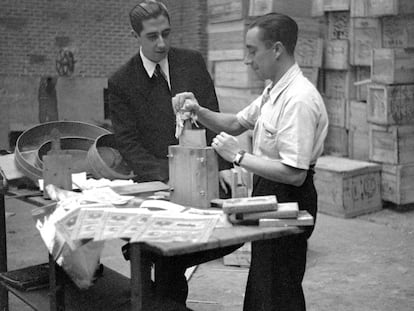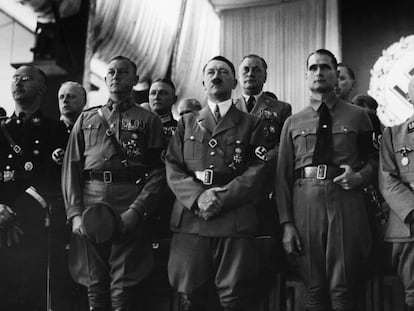Nobody wants to restore Franco’s train
The carriage in which the Spanish dictator traveled to meet Hitler in 1940 is still awaiting restoration

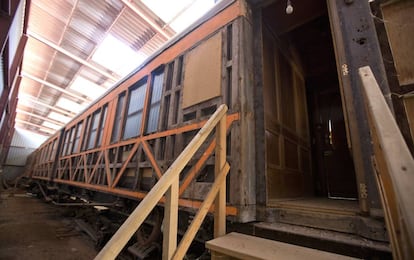
Without power or furniture, tucked away inside an old train station in Soria province, in Spain’s north. That’s where you will find the train Francisco Franco traveled in to Hendaye in the deep southwest of France, for his historic meeting with Adolf Hitler in 1940. The train been waiting more than 30 years to be fully restored and has spent six decades abandoned in a decrepit state as promises of restoration have gone unfulfilled.
Outside Almazán, in the middle of the silent Spanish highlands, it refuses to be forgotten as was the case with so many of these trains, which were dubbed SS-3 while in circulation. The interior of the train has been decently conserved thanks to work that took place in 2006, but without furniture it lacks its original luster. The train’s exterior long ago lost its olive green sheen and decorative yellow stripes and is instead covered with cobwebs.
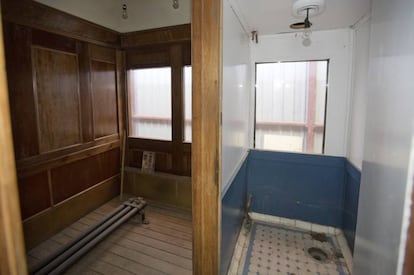
This train’s retirement has been anything but peaceful. After being auctioned off in 1975 for one million pesetas (€6,000) to an antique dealer who used the train as a meeting point for hunters on his ranch in Ciudad Real. The state then bought it back nine years later as 150 tons of scrap metal valued at 375,000 pesetas. The idea was to put it on display at the Rail Museum in Madrid but before this could happen it would need a thorough restoration.
But there has been no restoration for 30 years and nor does it look like there will be one anytime soon. During this time, a subsidiary of Madrid’s national train company Renfe, did actually began to restore the train in Soria but had to abandon it due to lack of funding. It was placed outside again, exposed to the elements where it became the refuge of a beggar. It was then moved 30 kilometers further south to Almazán, where it remained for two decades. Here it was put undercover and further restoration began, but this was again cut short for financial reasons. The last time someone worked on the train was over 11 years ago.
Today, nobody is planning on finishing the work that’s been left pending, even though everyone agrees it would not require a huge investment. The owners of the train, the Spanish Railways Foundation , explain in a terse email: “It’s not on the schedule. It is waiting an opportunity.” The association, which received the train in 1997 and organized its last restoration between 2004 and 2005, maintains that it is a not-for-profit organization financed by grants and that it does not have the funds to complete the work at the moment. “Thirteen years ago, the regions Castilla and León gave us €282,681 and from our budget we put forward another €23,000. We fixed the interior. We also built a warehouse to protect it,” says Maria Muñoz, the boss of Adema, an association that works in development in Almazán and the surrounding area. Local mayor José Antonio de Miguel, who would like to build “a train theme park with this carriage as the main attraction,” says that he has been unable to reach an agreement with Spanish rail company Adif, which oversees the management of most of Spain’s railway infrastructure, on the price of the land.
When Franco went to say goodbye to Hitler, the train jerked forward and the Spanish dictator almost fell out
The SS-3 has gone down in history for transporting Franco on October 23, 1940 to the French border. Here Hitler was waiting for him to discuss Spain’s possible participation in the Second World War. The dictator left first for San Sebastión by road (spending the night in Burgos) and on the day of his meeting with Hitler found himself on the train to Hendaye. He arrived eight minutes late, in part because of a power cut in the middle of the trip. “It was very short, less than a minute, but of course, we were all very nervous. At least we discovered the cause of the problem very quickly,” Salvador Domínguez, the mechanic’s assistant told EL PAÍS in 1985.
The Nazi leader waited on the platform but did not get on the Spanish train. All meetings took place in German. “The tone of the conversation would have been friendly, I cannot imagine either would be caustic. It was the start of the war and Hitler had arrived there after traveling through all of France,” explains historian Julián Casanova. From early afternoon until midnight, Franco and Hitler talked but they never reached an agreement. “Hitler did not accept Franco’s conditions and Franco left convinced that it was better not to take part in the conflict. In truth, Spain did not enter [the war] because of its military and economic situation,” he adds.
When it came to say goodbye, there was another scare. The Spanish dictator, instead of waving from the window, waved goodbye from the door. Just as this happened, the train jerked forward and Franco almost fell out, but was quickly pulled back by General José Moscardó and Commander Martínez Maza.
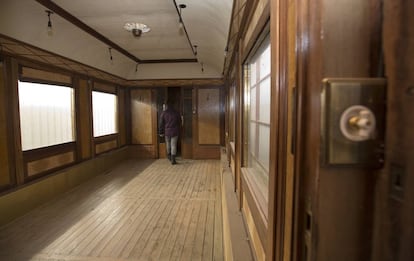
Constructed in Sestao in Vizcaya province in 1929, before the Franco regime, the train was used by King Alfonso XIII on his private and public travels. Inside the 20-meter long and three-meter wide train, the set-up is the same as when it was built: it includes a kitchen, a large meeting room, a corridor with three bedrooms (one with a shower which Franco used, the other two with just a sink) and a common bathroom. With the exception of the high-quality wood veneer, kitchen cupboards and three pipes that provided heating under the dictator’s bed, little is left of the original decoration from 75 years ago.
From photos from the era, we know that the main compartment had a brass bed, a small table and a footrest with cushions and tassels. In the dining room, there was a sofa, six chairs, a dresser, a mirror, a rectangular table and a beige rug. In the kitchen, there was a coal-fired stove. The entire train was kept warm with steam heating. “They haven’t brought us anything here for over 20 years. The ideal thing would be to recreate what it looked like in its time, with similar furniture,” says Marisa Muñoz. “And then we would have to explain very well, who used it, when and why” – more unfinished work from a restoration process which, 30 years on, is still incomplete, without a budget and without a deadline.
English version by Melissa Kitson.
Tu suscripción se está usando en otro dispositivo
¿Quieres añadir otro usuario a tu suscripción?
Si continúas leyendo en este dispositivo, no se podrá leer en el otro.
FlechaTu suscripción se está usando en otro dispositivo y solo puedes acceder a EL PAÍS desde un dispositivo a la vez.
Si quieres compartir tu cuenta, cambia tu suscripción a la modalidad Premium, así podrás añadir otro usuario. Cada uno accederá con su propia cuenta de email, lo que os permitirá personalizar vuestra experiencia en EL PAÍS.
¿Tienes una suscripción de empresa? Accede aquí para contratar más cuentas.
En el caso de no saber quién está usando tu cuenta, te recomendamos cambiar tu contraseña aquí.
Si decides continuar compartiendo tu cuenta, este mensaje se mostrará en tu dispositivo y en el de la otra persona que está usando tu cuenta de forma indefinida, afectando a tu experiencia de lectura. Puedes consultar aquí los términos y condiciones de la suscripción digital.
More information
Archived In
Últimas noticias
The brief rise and retreat of Generation Z in Mexico
From safe-haven investment to geostrategic weapon: Who owns the most gold and where are the bars kept?
Todd Green, head of the company that created ‘Candy Crush’: ‘Success for us is that players want to play for years’
Prices soar and Venezuela’s economy struggles under Trump’s pressure: ‘People are living day to day’
Most viewed
- Why we lost the habit of sleeping in two segments and how that changed our sense of time
- Charles Dubouloz, mountaineering star, retires at 36 with a farewell tour inspired by Walter Bonatti
- Venezuela faces its most tense Christmas yet
- Trump’s obsession with putting his name on everything is unprecedented in the United States
- CBS in crisis after pulling a report on Trump’s deportations to El Salvador (which later leaked online)
